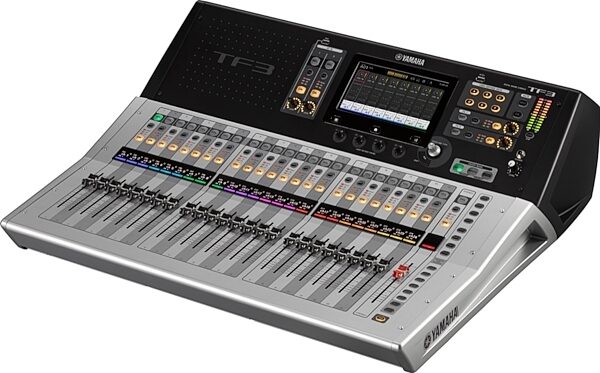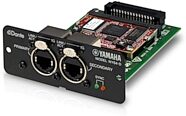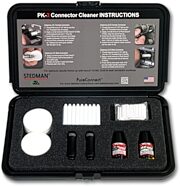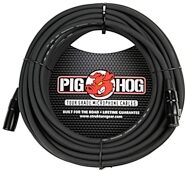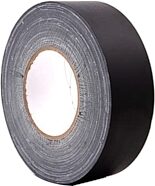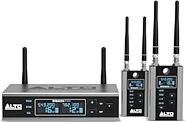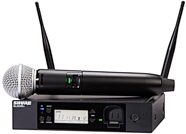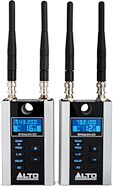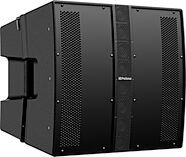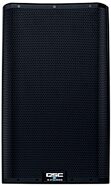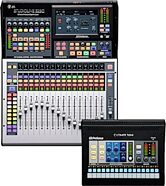Yamaha TF3 Digital Mixer
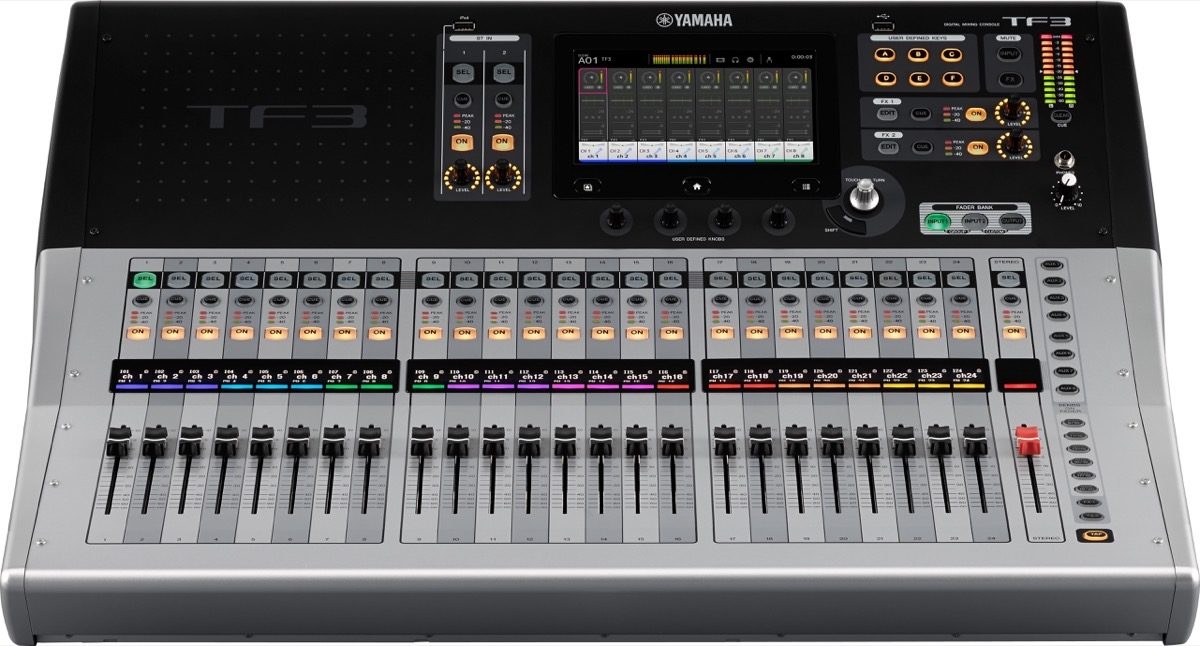
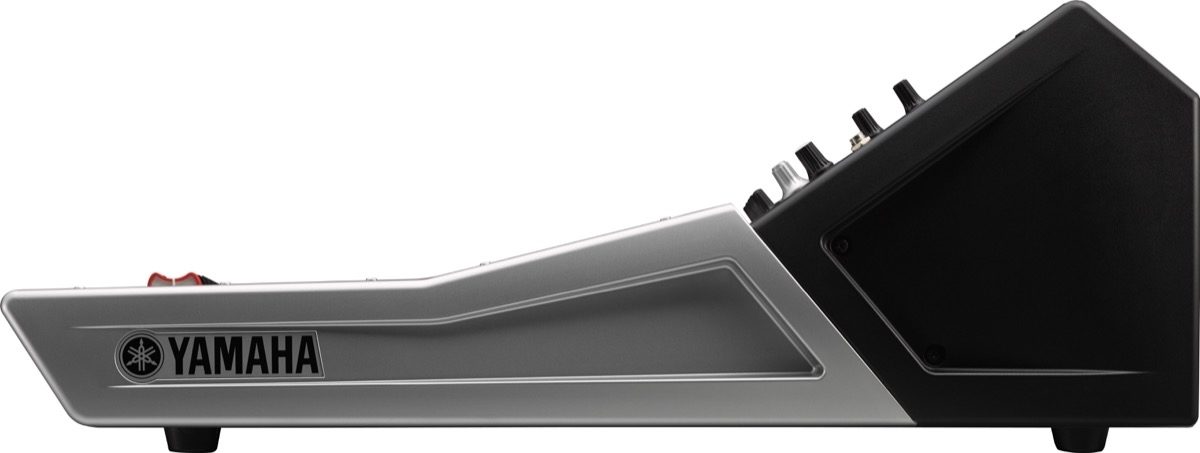
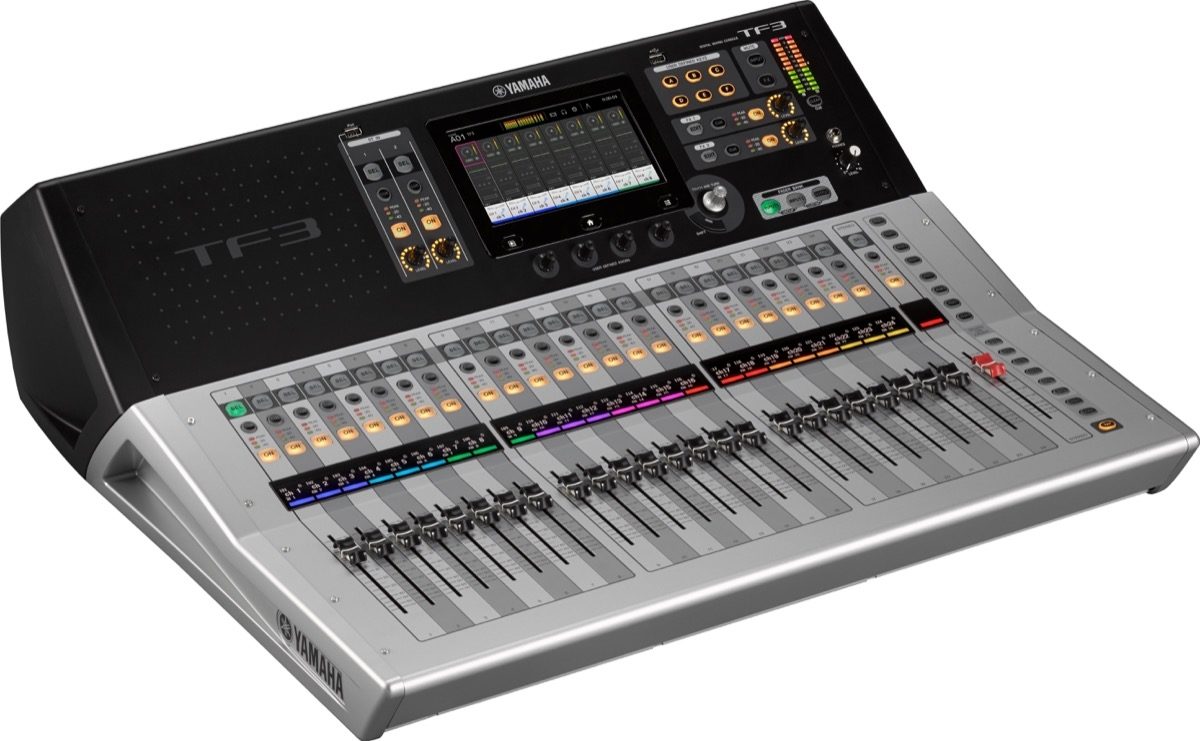



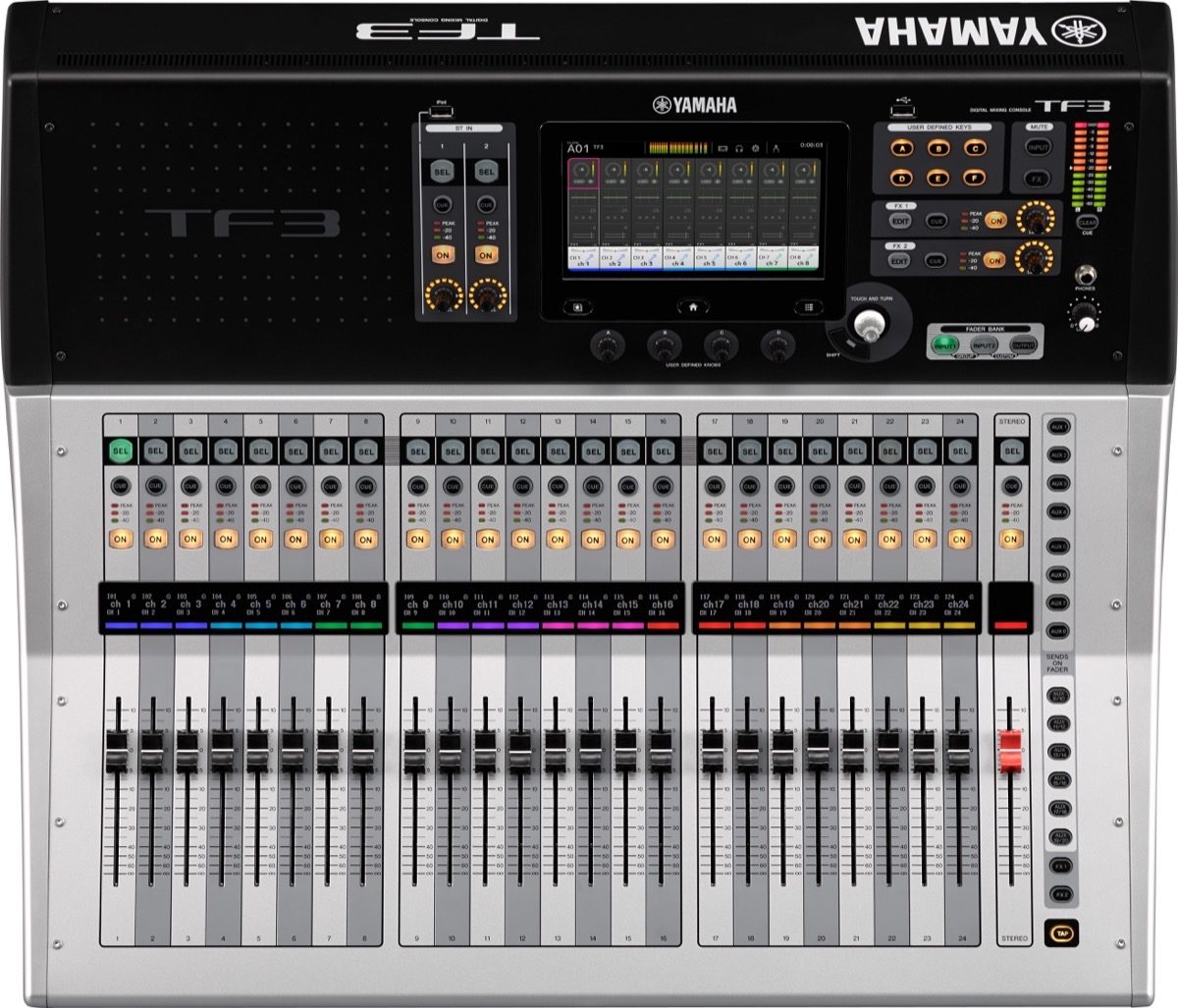
Build bigger, better mixes! Yamaha's TF3 digital mixer boasts 24 mic preamp channels with 100 mm motor faders, and a touchscreen for dialing in processing.
Overview
In developing the TF series Yamaha engineers built from their existing base of acclaimed high-end mixer interfaces, adding intuitive control in an interface optimized for the type of touch panel control that has become a familiar feature in a wide range of applications. Allowing most operations to be carried out via the touch panel alone, the innovative TF series interface will quickly become second nature to a broad spectrum of users. Whether you have experience with Yamaha digital consoles, work with other digital consoles, operate analog consoles, or have never operated a mixer before, TF consoles will lead you to the desired results quickly and effortlessly through a smooth, efficient workflow. The availability of physical controls surrounding the touch panel further enhances control versatility and precision.
TouchFlow Operation introduced in the TF series consoles allows the user to respond to the music and artists on stage with unprecedented speed and freedom, taking live sound reinforcement to a high level of refinement. With the TouchFlow Operation interface optimized for touch panel control, experienced engineers as well as newcomers to the field will find it easier than ever to achieve the ideal mix. Recallable D-PRE preamplifiers support sound quality that will satisfy the most discerning professional ears, while advanced live recording features and seamless operation with high-performance I/O racks give these compact digital mixers capabilities that make them outstanding… read more choices for a wide range of applications. Experience the intuitive control and creative freedom that a truly evolved digital console can provide.
Learn everything you need to know about the Yamaha TF series mixers in this video series:
- 48 input mixing channels (40 mono + 2 stereo + 2 return)
- 20 Aux (8 mono + 6 stereo) + Stereo + Sub buses
- 8 DCA groups with Roll-out
- 24 analog XLR/TRS combo mic/line inputs + 2 analog RCA pin stereo line inputs
- 16 analog XLR outputs
- 34 x 34 digital record/playback channels via USB 2.0 + 2 x 2 via a USB storage device
- 1 expansion slot for NY64-D audio interface card
read less
TouchFlow Operation introduced in the TF series consoles allows the user to respond to the music and artists on stage with unprecedented speed and freedom, taking live sound reinforcement to a high level of refinement. With the TouchFlow Operation interface optimized for touch panel control, experienced engineers as well as newcomers to the field will find it easier than ever to achieve the ideal mix. Recallable D-PRE preamplifiers support sound quality that will satisfy the most discerning professional ears, while advanced live recording features and seamless operation with high-performance I/O racks give these compact digital mixers capabilities that make them outstanding… read more choices for a wide range of applications. Experience the intuitive control and creative freedom that a truly evolved digital console can provide.
TouchFlow Operation -- Smooth, Natural Control Flow
Yamaha digital consoles have always been designed with input from leading engineers worldwide to ensure that the most efficient, intuitive operation is achieved. The highly regarded Selected Channel and Centralogic interfaces attest to the success of that approach. The TF series combines Yamaha know-how with input from the field and the latest touch-screen technology to deliver an evolved experience in console operation. Smooth setup and operation, practical presets and scenes, refined design, and software applications that integrate seamlessly with the entire system: these elements comprise TouchFlow Operation, a concept in console interfaces that offers unprecedented comfort and convenience in small consoles, for a wide range of users and applications.Touch Operation for Intimate Control
Refined for the smoothest possible operation via touch-panel control, the TF user interface offers a smooth workflow that can be an advantage in any mixing situation. The display content has been specifically designed for easy, direct accessibility, with a layout that promotes the most natural, efficient mixing. Touch panel operation is as easy as shaping the sound with your fingertips.Touch & Turn Knob Offers Extra Control Precision
When you need extra precision for a fine EQ or other adjustment, the physical Touch & Turn knob is always available right beside the touch panel. There are also four User Defined Knobs below the panel that can be assigned to control compressor threshold, EQ gain, or other parameters you need fast, direct access to while mixing. The knobs always affect the currently selected channel.Traditional Overview and Selected Channel Interfaces
The overview display shows the parameters for eight channels at a time, while the Touch & Turn knob provides direct access to gain, 1-knob EQ, 1-knob COMP, gate threshold, effect send level, pan, and other parameters. Touch the highlighted parameter a second time to switch to the Selected Channel display when you need access to detailed parameters for finer control.Features for Smooth Setup and Operation
Effective gain, compressor, and EQ setup requires a considerable degree of skill and experience. Even veteran engineers need to spend time on these important basic settings. In addition to their intuitive user interfaces, TF consoles include a number of features that contribute to faster, smoother setup of these essential parameters.1-knob COMP & 1-knob EQ: One Knob to Dial In the Ideal Sound
An experienced engineer can do a lot with a compressor: bring a guitar to life, add punch to bass, tighten up a snare, and make vocals ride clearly on the mix. The 1-knob COMP can do all of this quickly and easily, without the need to juggle multiple parameters to achieve the desired effect. 1-knob EQ has been painstakingly fine-tuned by Yamaha R&D staff in cooperation with distinguished sound engineers, to ensure that you can achieve outstanding results with minimum effort in the shortest possible time. A Vocal Mode makes it easier than ever to achieve a clear, well defined vocal sound, while an Intensity Mode offers 1-knob "intensity" control over EQ curves you either select from the presets or create from scratch. But there's more: the 1-knob COMP and 1-knob EQ are provided on the output channels too, so you can quickly achieve overall output compression or EQ that ideally matches the room and audience size. The output 1-knob EQ has a Loudness Mode in place of the Vocal Mode, effectively increasing the sound pressure level while maintaining optimum sound as you rotate the knob. Both the 1-knob COMP and 1-knob EQ provide quick access to the full compressor and EQ displays, so you can fine tune settings as required.GainFinder Supports Precision Gain Setup
Gain is the first adjustment the input signal sees, and the way it is set up influences how subsequent parameters will affect the signal. The GainFinder feature facilitates optimum gain setup for individual input signals so that ideal overall operation and signal quality is achieved. The user only has to set channel gain so that the central green indicator in the level meter remains lit for the longest possible time.Practical Presets and Scenes -- Shortcuts to Great Sound
The familiar Yamaha scene memory that stores mix settings for instant recall when needed is included as always. There's also a range of channel presets that have been created in cooperation with leading microphone manufacturers and eminent sound engineers, providing starting points that take you a long way towards achieving great sound. The channel presets cover parameters such as HA gain, EQ, dynamics, and much more, right down to details like channel name and color. Less time needs to be spent on basic setup so that more time is available for refining the mix and communicating with the performers.QuickPro Presets Provide Instant Access to Pro Sound Setups
Armed with these practical presets even the novice engineer can get very close to the ideal sound, while experienced engineers will appreciate the significant time savings they can provide starting points for further adjustments. The QuickPro Presets can be searched by instrument type and recalled quickly and easily. The presets include HA gain, EQ, Comp and other settings, right down to the channel name and color. The 1-knob EQ and 1-knob COMP can be used with QuickPro Presets, providing a super streamlined way to tweak the sound. The output channel preset library includes parameter sets optimized for Yamaha powered speakers, with several variations to match different environments and room sizes. Presets are provided for in-ear monitors too. All of these can be used as is when time is tight, but they are also great starting points for manual fine tuning. Setups created from the presets or from scratch can be saved as additional presets too.Two Scene Memory Banks
The scene memory features banks A and B, each capable of holding up to 100 scenes. That's a total of 200 scenes that can be set up and instantly recalled whenever needed. A number of scenes are pre-programmed to give users a head start: scenes with the 1-knob COMP and 1-knob EQ controls engaged for the easiest possible operation, and scenes with the 1-knob features disabled for experienced engineers who might want to follow an established procedureDesign for Superior Visibility and Quick Operation
The TF series hardware is packed with features that contribute to superior operability and convenience. Faders, knobs, and buttons with outstanding fit and feel work seamlessly with state-of-the-art display technology, including high-visibility channel name and color displays. The touch panel itself offers an ideal blend of comprehensive visual feedback and fast response. The physical layout of these components brings everything together in a system that offers surprisingly efficient workflow.Panel Layout Maximizes Workflow Efficiency
Careful analysis of the workflows favored by a large number of engineers has led to a highly efficient panel layout. Rather than simply providing a long list of advanced features, the TF consoles present meaningful features in the most logical and accessible way through an overall design that maximizes visibility and operability.Comprehensive Fader Bank section
Two INPUT banks and one OUTPUT bank are provided, and the GROUP bank can be selected by pressing both the INPUT bank buttons simultaneously. The GROUP bank allows the levels of multiple channels to be controlled from a single DCA fader. There's also a CUSTOM fader bank where you can assign any input, output, and DCA group to any fader.DCA Roll-out Enhances Group Control
When the GROUP fader bank is selected, all faders other than DCA masters 1 through 8 function as Roll-out faders. Selecting one of the DCA groups instantly "rolls out" the input channels belonging to that group to the Roll-out faders. This useful function makes it easy to adjust the level and other parameters of individual channels while using the eight DCA faders for overall mixing.Channel Name and Color
A display panel located above each channel fader shows the assigned channel name or ID, the port name, and the current fader setting. Phantom power status as well as gate and comp operation can also be displayed. A color bar that shows the assigned channel color makes visual navigation a breeze, and prevents confusion when fader banks are changed or scenes are recalled.Faders Provide a Clear View of All Inputs
The TF5 has 33 motor faders, the TF3 has 25, and the TF1 has 17. All rear-panel inputs have individual faders so their status can be verified at a glance and they can be directly and immediately accessed for control.SENDS ON FADER section
The SENDS ON FADER buttons instantly bring the specified AUX or FX bus levels up on the faders for easy verification and adjustment. When a SENDS ON FADER button is engaged the MASTER fader acts as the master for the corresponding bus, so AUX levels can be checked and controlled without having to switch fader banks.Advanced Design Promotes Smooth, Comfortable Operation
The upper section of the panel is designed to double as a rest for an iPad, set list, score, memos, and/or other small items. The panel consists of three angled sections that give the operator maximum visibility and access.Learn everything you need to know about the Yamaha TF series mixers in this video series:
Features:
- 25 motor faders (24 channels + 1 master)- 48 input mixing channels (40 mono + 2 stereo + 2 return)
- 20 Aux (8 mono + 6 stereo) + Stereo + Sub buses
- 8 DCA groups with Roll-out
- 24 analog XLR/TRS combo mic/line inputs + 2 analog RCA pin stereo line inputs
- 16 analog XLR outputs
- 34 x 34 digital record/playback channels via USB 2.0 + 2 x 2 via a USB storage device
- 1 expansion slot for NY64-D audio interface card
WARNING: Cancer and Reproductive Harm - www.p65Warnings.ca.gov.
Specs
- Fader Configuration: 24 + 1 (Master)
- Input Channels: 48 (40 mono + 2 stereo + 2 return)
- Aux Buses: 20 (8 mono + 6 stereo)
- Stereo Buses: 1
- Sub Buses: 1
- Input channel functions: 8 DCA Groups
- Inputs: 24 mic/line (XLR/TRS combo) + 2 stereo line (RCA pin)
- Outputs: 16 (XLR)
- Expansion slots: 1
- DSP: 8 Effects + 10 GEQ
- USB: 34x34 USB Audio Interface, 2-track recording via USB Storage Device
- Sampling frequency rate: 48 kHz
- Signal delay: Less than 2.6 ms, INPUT to OMNI OUT, Fs=48 kHz
- Fader: 100 mm motorized, Resolution = 10-bit, +10 dB to -138 dB, -dB all faders
- Total harmonic distortion: Less than 0.05% 20 Hz-20 kHz @+4 dBu into 600 , INPUT to OMNI OUT, Input Gain=Min.
- Frequency response: +0.5, -1.5 dB 20 Hz-20 kHz, refer to +4 dBu output @1kHz, INPUT to OMNI OUT
- Dynamic range: 110 dB typ., DA Converter, 107 dB typ., INPUT to OMNI OUT, Input Gain=Min.
- Hum & noise level: Equivalent input noise: -128 dBu typ., Input Gain=Max.
- Residual output noise: -85 dBu, ST master off
- Crosstalk: -100 dB, adjacent INPUT/OMNI OUT channels, Input Gain=Min.
- Power requirements: 100-240 V 50/60 Hz
- Power consumption: 110 W
- Dimensions: 28.2 x 8.9 x 23.6" (716 x 225 x 599mm)
- Net weight: 37.5 lb (17.0 kg)
- Accessories: Quick Guide, Power Cord, CUBASE AI download information
- Operating temperature range: 0-40 C, Storage temperature range: -20-60 C
- Input Channels: 48 (40 mono + 2 stereo + 2 return)
- Aux Buses: 20 (8 mono + 6 stereo)
- Stereo Buses: 1
- Sub Buses: 1
- Input channel functions: 8 DCA Groups
- Inputs: 24 mic/line (XLR/TRS combo) + 2 stereo line (RCA pin)
- Outputs: 16 (XLR)
- Expansion slots: 1
- DSP: 8 Effects + 10 GEQ
- USB: 34x34 USB Audio Interface, 2-track recording via USB Storage Device
- Sampling frequency rate: 48 kHz
- Signal delay: Less than 2.6 ms, INPUT to OMNI OUT, Fs=48 kHz
- Fader: 100 mm motorized, Resolution = 10-bit, +10 dB to -138 dB, -dB all faders
- Total harmonic distortion: Less than 0.05% 20 Hz-20 kHz @+4 dBu into 600 , INPUT to OMNI OUT, Input Gain=Min.
- Frequency response: +0.5, -1.5 dB 20 Hz-20 kHz, refer to +4 dBu output @1kHz, INPUT to OMNI OUT
- Dynamic range: 110 dB typ., DA Converter, 107 dB typ., INPUT to OMNI OUT, Input Gain=Min.
- Hum & noise level: Equivalent input noise: -128 dBu typ., Input Gain=Max.
- Residual output noise: -85 dBu, ST master off
- Crosstalk: -100 dB, adjacent INPUT/OMNI OUT channels, Input Gain=Min.
- Power requirements: 100-240 V 50/60 Hz
- Power consumption: 110 W
- Dimensions: 28.2 x 8.9 x 23.6" (716 x 225 x 599mm)
- Net weight: 37.5 lb (17.0 kg)
- Accessories: Quick Guide, Power Cord, CUBASE AI download information
- Operating temperature range: 0-40 C, Storage temperature range: -20-60 C
- Dimensions and Weight in Packaging
- Base Item
- Shipping Weight: 52 lbs
- Shipping Dimensions: 32 x 29 x 13 in
- Manufacturer Part Number (MPN): TF3
Documents and Manuals
For support or warranty questions, please contact the manufacturer:
Phone: 714-522-9011
Web: https://usa.yamaha.com/support
Phone: 714-522-9011
Web: https://usa.yamaha.com/support
New
Was $2,799.99
Save $280 thru June 30
$2,519.99
- 12 x$210.00
Save $280! Was $2799.99, now $2519.99
- For a limited time, save $280 when you buy a Yamaha TF3 at zZounds. Hurry -- ends June 30!
This is a carousel with product cards. Use the previous and next buttons to navigate.
People who bought this item also bought
This is a carousel with product cards. Use the previous and next buttons to navigate.





